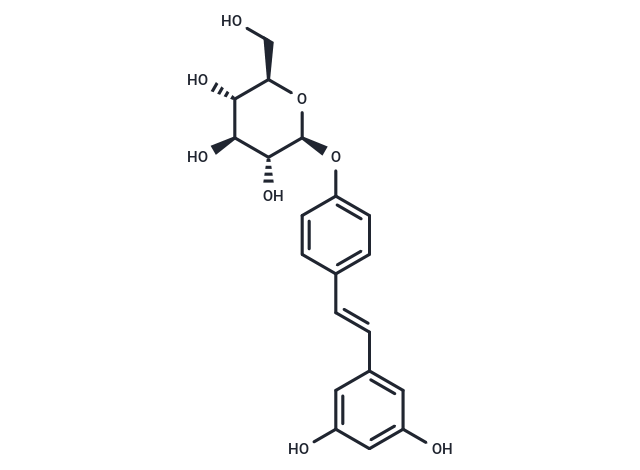Shopping Cart
- Remove All
 Your shopping cart is currently empty
Your shopping cart is currently empty

Resveratroloside has cardioprotective effect, it exhibits α±-glucosidase inhibitory activity, it also can inhibit hydroxylation of testosterone by CYP3A4.

| Pack Size | Price | Availability | Quantity |
|---|---|---|---|
| 1 mg | $90 | In Stock | |
| 5 mg | $215 | In Stock | |
| 10 mg | $318 | In Stock | |
| 25 mg | $536 | In Stock | |
| 50 mg | $773 | In Stock |
| Description | Resveratroloside has cardioprotective effect, it exhibits α±-glucosidase inhibitory activity, it also can inhibit hydroxylation of testosterone by CYP3A4. |
| In vitro | To discuss if the invasive variety is chemically identical to the native one in traditional medicine, the different constituents of the invasive variety compared to the native variety were isolated and their anti-inflammatory activity was tested. Resveratroloside and catechin-(4α±??8)-catechin, the newly found constituents in the invasive variety, have similar nitric oxide (NO) inhibition potency as that of piceid (the major constituent of P. cuspidatum), but the newly found major constituent, i.e., piceatannol glucoside, showed no apparent effect. On the other hand, as a marker, the total content of resveratrol in the methanol root extract after glucosidase hydrolysis was measured and compared between the invasive and native varieties. |
| Molecular Weight | 390.38 |
| Formula | C20H22O8 |
| Cas No. | 38963-95-0 |
| Smiles | OC[C@H]1O[C@@H](Oc2ccc(\C=C\c3cc(O)cc(O)c3)cc2)[C@H](O)[C@@H](O)[C@@H]1O |
| Relative Density. | 1.521 g/cm3 (Predicted) |
| Storage | store at low temperature,store under nitrogen | Powder: -20°C for 3 years | In solvent: -80°C for 1 year | Shipping with blue ice. |

Copyright © 2015-2024 TargetMol Chemicals Inc. All Rights Reserved.